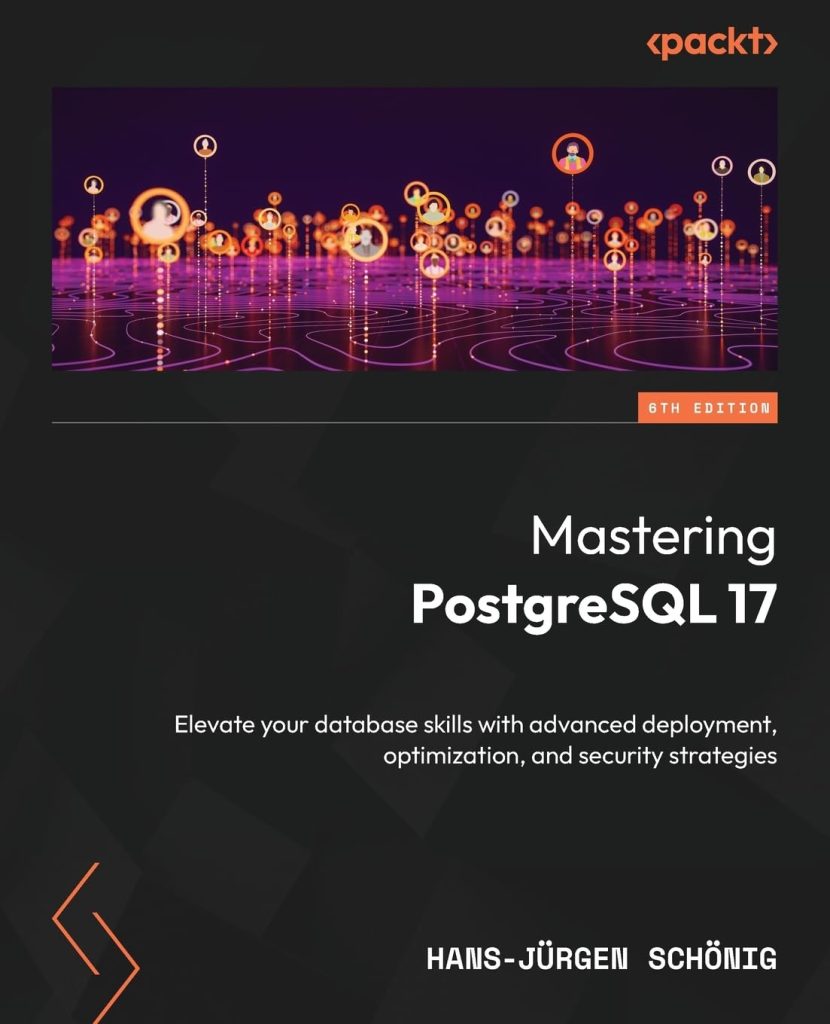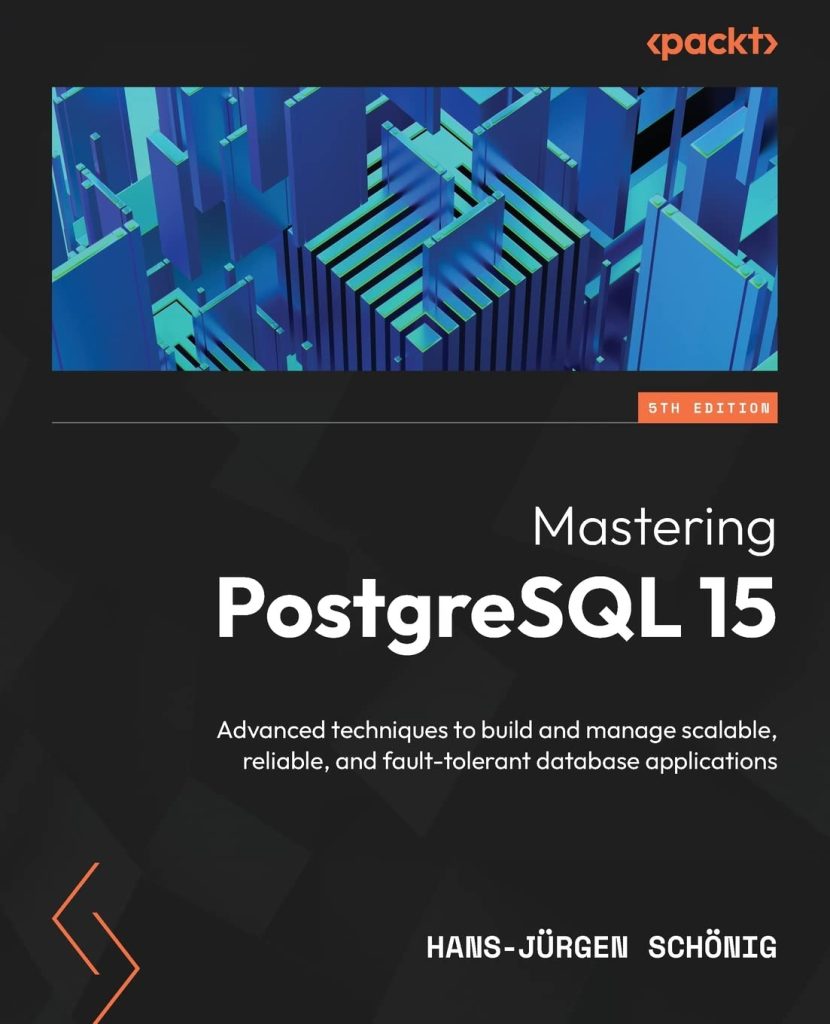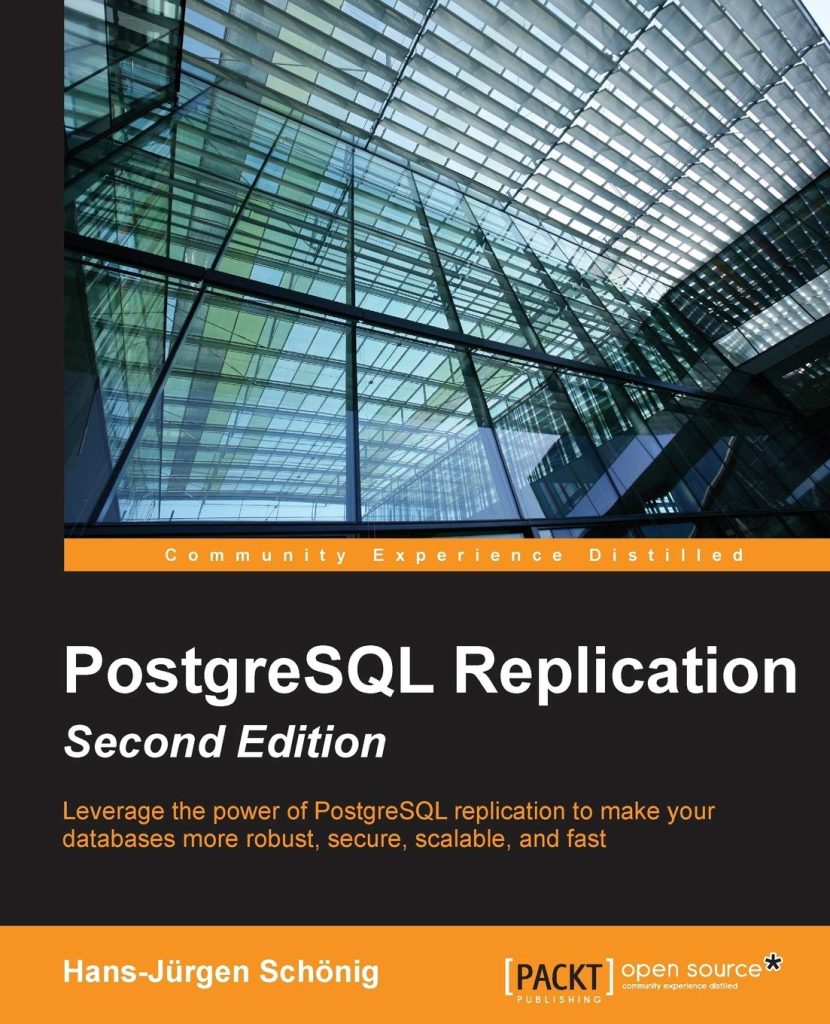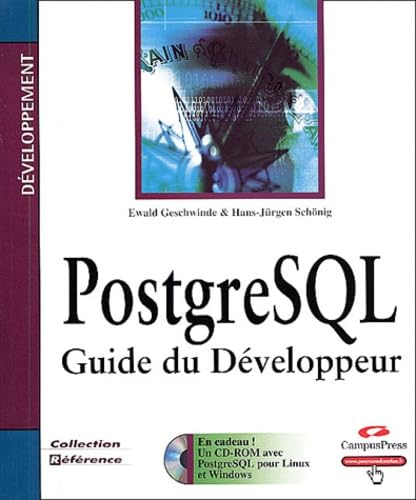Our CEO, Hans-Jürgen Schönig, regularly publishes PostgreSQL books and introduces you to important features of each version to efficiently manage and maintain your database. Have a look for yourself!

Starting with new features introduced in PostgreSQL 17, the sixth edition of this book provides comprehensive insights into advanced database management, helping you elevate your PostgreSQL skills to an expert level. Written by Hans-Jürgen Schönig, a PostgreSQL expert with over 25 years of experience and the CEO of CYBERTEC PostgreSQL International GmbH, this guide distills real-world expertise from supporting countless global customers. It guides you through crucial aspects of professional database management, including performance tuning, replication, indexing, and security strategies.
You’ll learn how to handle complex queries, optimize execution plans, and enhance user interactions with advanced SQL features such as window functions and JSON support. Hans equips you with practical approaches for managing database locks, transactions, and stored procedures to ensure peak performance. With real-world examples and expert solutions, you'll also explore replication techniques for high availability, along with troubleshooting methods to detect and resolve bottlenecks, preparing you to tackle everyday challenges in database administration.
By the end of the book, you'll be ready to deploy, secure, and maintain PostgreSQL databases efficiently in production environments.
This book is for database administrators, PostgreSQL developers, and IT professionals who want to implement advanced functionalities and tackle complex administrative tasks using PostgreSQL 17. A foundational understanding of PostgreSQL and core database concepts is essential, along with familiarity with SQL. Prior experience in database administration will enhance your ability to leverage the advanced techniques presented in this book.

Starting with an introduction to the newly released features of PostgreSQL 15, this updated fifth edition will help you get to grips with PostgreSQL administration and how to build dynamic database solutions for enterprise apps, including designing both physical and technical aspects of the system.
You'll explore advanced PostgreSQL features, such as logical replication, database clusters, advanced indexing, and user management to manage and maintain your database. You'll then work with the PostgreSQL optimizer, configure PostgreSQL for high speed, and move from Oracle to PostgreSQL. Among the other skills that the book will help you build, you'll cover transactions, handling recursions, working with JSON and JSONB data, and setting up a Patroni cluster. It will show you how to improve performance with query optimization. You'll also focus on managing network security and work with backups and replication while exploring useful PostgreSQL extensions that optimize the performance of large databases.
By the end of this PostgreSQL book, you'll be able to use your database to its utmost capacity by implementing advanced administrative tasks with ease.
This database administration book is for PostgreSQL developers, database administrators, and professionals who want to implement advanced functionalities and master complex administrative tasks with PostgreSQL 15. Prior experience in PostgreSQL and familiarity with the basics of database administration will assist with understanding key concepts covered in the book.

Thanks to its reliability, robustness, and high performance, PostgreSQL has become one of the most advanced open source databases on the market. This updated fourth edition will help you understand PostgreSQL administration and how to build dynamic database solutions for enterprise apps with the latest release of PostgreSQL, including designing both physical and technical aspects of the system architecture with ease.
Starting with an introduction to the new features in PostgreSQL 13, this book will guide you in building efficient and fault-tolerant PostgreSQL apps. You’ll explore advanced PostgreSQL features, such as logical replication, database clusters, performance tuning, advanced indexing, monitoring, and user management, to manage and maintain your database. You’ll then work with the PostgreSQL optimizer, configure PostgreSQL for high speed, and move from Oracle to PostgreSQL. The book also covers transactions, locking, and indexes, and shows you how to improve performance with query optimization. You’ll also focus on how to manage network security and work with backups and replication while exploring useful PostgreSQL extensions that optimize the performance of large databases.
By the end of this PostgreSQL book, you’ll be able to get the most out of your database by executing advanced administrative tasks.
This database administration book is for PostgreSQL developers and database administrators and professionals who want to implement advanced functionalities and master complex administrative tasks with PostgreSQL 13. Prior experience in PostgreSQL and familiarity with the basics of database administration will assist with understanding key concepts covered in the book.

Thanks to its reliability, robustness, and high performance, PostgreSQL has become the most advanced open source database on the market. This third edition of Mastering PostgreSQL helps you build dynamic database solutions for enterprise applications using the latest release of PostgreSQL, which enables database analysts to design both physical and technical aspects of system architecture with ease.
Starting with an introduction to the newly released features in PostgreSQL 12, this book will help you build efficient and fault-tolerant PostgreSQL applications. You’ll thoroughly examine the advanced features of PostgreSQL, including logical replication, database clusters, performance tuning, monitoring, and user management. You’ll also work with the PostgreSQL optimizer, configure PostgreSQL for high speed, and understand how to move from Oracle to PostgreSQL. As you progress through the chapters, you’ll cover transactions, locking, indexes, and how to optimize queries for improved performance. Additionally, you’ll learn how to manage network security and explore backups and replications while understanding useful PostgreSQL extensions to help you in optimizing the performance of large databases.
By the end of this PostgreSQL book, you’ll be able to get the most out of your database by implementing advanced administrative tasks effortlessly.

This second edition of Mastering PostgreSQL 11 helps you build dynamic database solutions for enterprise applications using the latest release of PostgreSQL, which enables database analysts to design both the physical and technical aspects of the system architecture with ease.
This book begins with an introduction to the newly released features in PostgreSQL 11 to help you build efficient and fault-tolerant PostgreSQL applications. You’ll examine all of the advanced aspects of PostgreSQL in detail, including logical replication, database clusters, performance tuning, monitoring, and user management. You will also work with the PostgreSQL optimizer, configuring PostgreSQL for high speed, and see how to move from Oracle to PostgreSQL. As you progress through the chapters, you will cover transactions, locking, indexes, and optimizing queries to improve performance. Additionally, you’ll learn to manage network security and explore backups and replications, while understanding the useful extensions of PostgreSQL so that you can optimize the speed and performance of large databases.
By the end of this book, you will be able to use your database to its utmost capacity by implementing advanced administrative tasks with ease.

PostgreSQL is an open source database used for handling large datasets (big data) and as a JSON document database. This book highlights the newly introduced features in PostgreSQL 10, and shows you how you can build better PostgreSQL applications, and administer your PostgreSQL database more efficiently. We begin by explaining advanced database design concepts in PostgreSQL 10, along with indexing and query optimization. You will also see how to work with event triggers and perform concurrent transactions and table partitioning, along with exploring SQL and server tuning. We will walk you through implementing advanced administrative tasks such as server maintenance and monitoring, replication, recovery, high availability, and much more. You will understand common and not-so-common troubleshooting problems and how you can overcome them. By the end of this book, you will have an expert-level command of advanced database functionalities and will be able to implement advanced administrative tasks with PostgreSQL 10.

PostgreSQL is an open source database used for handling large datasets (Big Data) and as a JSON document database. It also has applications in the software and web domains. This book will enable you to build better PostgreSQL applications and administer databases more efficiently.
We begin by explaining the advanced database design concepts in PostgreSQL 9.6, along with indexing and query optimization. You will also see how to work with event triggers and perform concurrent transactions and table partitioning, along with exploring SQL and server tuning. We will walk you through implementing advanced administrative tasks such as server maintenance and monitoring, replication, recovery and high availability, and much more. You will understand the common and not-so-common troubleshooting problems and how you can overcome them.
By the end of this book, you will have an expert-level command of the advanced database functionalities and will be able to implement advanced administrative tasks with PostgreSQL.

If you are a database administrator looking for solutions to common PostgreSQL problems, this is the book for you. The book is suitable for people with intermediate and professional expertise.
PostgreSQL is a powerful, open source, object-relational database system. PostgreSQL offers many advantages for your company or business over other database systems.
This book is your practical guide to understanding the advanced techniques used to handle complex data and methods to solve issues that you might face while working with PostgreSQL. We will start with discussing the issues that arise at the time of setting up PostgreSQL. The next step will be to decide which data types will be most suitable to the task at hand and optimize performance using the right ones.
We will understand how to deal with transaction locks, fuzzy matches, cursors, joins, and so on. Know the warning signs to look for, and how to avoid the most common issues before they even happen. In addition to that, specific high-level topics such as replication and Point-In-Time-Recovery will be discussed. The entire book is based on PostgreSQL 9.4 and contains up-to-date information.

With more than a quarter of a century of development and innovation, PostgreSQL has gained a reputation for stability, robustness, and ease of use. The variety of features available within PostgreSQL makes it a powerful tool for your professional relational database infrastructure.
Order on Amazon
Kindle Ebook Edition
Order at Packt Publishing
With the database administrator in mind, this compact, easy-to-read, and practically oriented book will make your daily handling of PostgreSQL more efficient and rewarding. You will learn about optimization, bottleneck detection, backup and recovery, replication, logfile management, indexing, and much more in a systematic and carefully structured manner. This invaluable guide will enable you to develop the fundamental skills required to deploy PostgreSQL in order to efficiently manage your databases.
Discover efficient ways to administer, monitor, replicate, and handle your PostgreSQL databases.

Leverage the power of PostgreSQL replication to make your databases more robust, secure, scalable, and fast
PostgreSQL offers a comprehensive set of replication related features. Unleashing the power of PostgreSQL provides you with countless opportunities and a competitive advantage over other database systems.
This book will guide you through the most important concepts of PostgreSQL replication. It contains all the information you need to design and operate replicated setups.
Beginning by giving you an understanding of replication concepts, the PostgreSQL transaction log, and Point-in-time Recovery, we gradually move on to setting up asynchronous and synchronous replication. Next up, you will learn to monitor a PostgreSQL cluster setup, deal with monitoring tools, and then move on to understanding Linux High Availability. Further, we explore widely-used tools such as Slony, SkyTools, Postgres-XC, and walbouncer, and set up PL/Proxy.
Finally, you'll get acquainted with the new technology of BDR, which allows bidirectional replication in PostgreSQL.
This book is ideal for PostgreSQL administrators who want to set up and understand replication. By the end of the book, you will be able to make your databases more robust and secure by getting to grips with PostgreSQL replication.

Leverage the power of PostgreSQL replication to make your databases more robust, secure, scalable, and fast
PostgreSQL est considéré comme le système de bases de données open source le plus avancé actuellement disponible. Grâce à cet ouvrage, PostgreSQL n'aura plus de secrets pour vous : vous découvrirez le langage et sa syntaxe ainsi que l'orientation objet, PL/pgSQL et les interfaces de programmation PostgreSQL pour le C, le C++, Perl, PHP, Java, Python, etc. Après avoir vu comment installer et configurer PostgreSQL sur les plateformes Windows et Unix/Linux, vous aborderez les systèmes de bases de données relationnelles supportant la norme ANSI SQL92 : tables, clés, objets, vues, structures complexes, etc. Vous étudierez également le langage PL/pgSQL qui constitue une extension permettant de dépasser les limites propres à SQL. Vous verrez ensuite les aspects avancés de l'administration de bases de données ainsi que les techniques utilisées pour générer des sauvegardes fiables qui permettent une récupération de données en cas de problème d'intégrité des données. Enfin, vous apprendrez à optimiser votre base de données en améliorant la qualité de votre code SQL et en adaptant votre système matériel pour tirer parti au mieux des possibilités de PostgreSQL. Une partie importante de l'ouvrage est consacrée aux API de contrôle de PostgreSQL à partir de nombreux langages ainsi qu'à l'étude de cas concrets répondant aux problèmes couramment rencontrés.

PostgreSQL is an object-relational database server that is widely considered to be the world’s most advanced open-source database system. It is ANSI SQL-compatible, and it offers powerful features to enable more complex software design than would be possible with relational databases that are not object-oriented. PostgreSQL is extremely modular, it supports a large number of datatypes, and programming interfaces for PostgreSQL are available for all important programming languages, including C, Perl, Python, Tcl, Java, and PHP. PostgreSQL Developer’s Handbook provides a complete overview of the PostgreSQL database server and extensive coverage of its core features, including object orientation, PL/pgSQL, and the most important programming interfaces. The book introduces the reader to the language and syntax of PostgreSQL and then moves quickly into advanced programming topics.

There is a strong demand for books that describe how to use PHP together with a specific open-source database to develop Web applications. While MySQL is very popular, PostgreSQL is widely considered to be the more powerful of the two open-source databases. And PostgreSQL is rapidly gaining market share-large organizations are beginning to use PostgreSQL instead of Oracle; the demand for PostgreSQL training and support has increased by some accounts 50% in the last six months; and Web hosting services increasingly offer PostgreSQL along with MySQL. PHP & PostgreSQL Advanced Web Programming focuses on the specific needs of a PostgreSQL developer and will detail how to make use of PostgreSQL’s unique, advanced features to develop high-availability, fail-safe Web applications with PHP and PostgreSQL.

Mono ist das Open Source-Framework für Programmierung und Einsatz .NET-kompatibler Anwendungen unter Unix, Linux und Windows. Mono vereint die Vorteile der großen Frameworks .NET und J2EE – Sprach- und Plattformunabhängigkeit – mit den Vorzügen freier Software. Dieses Buch bietet Ihnen als Profi-Programmiererin oder -Programmierer eine praxisorientierte und uebersichtliche Einführung in Mono und die NET-Kernsprache C#. Es beschreibt umfassend und übersichtlich alle relevanten Aspekte der Anwendungsentwicklung – von Datentypen und Klassen bis hin zu Thread-, Netzwerk- und GUI-Programmierung (mit gtk# und Qt#). Das Vorwort schrieb Mono-Gründer Miguel de Icaza.

Dies ist ein Buch für Datenbankprofis, die nach PostgreSQL migrieren und einen Einstieg in Administration und Programmierung der Open Source-Datenbank auf hohem Niveau suchen. Aufbauend auf einer Einführung in PostgreSQL, seine Installation, Administration, Optimierung und einem Tutorial zur Arbeit mit SQL, führen die Autoren praxis- und lösungsorientiert in die Arbeit mit den wichtigsten Programmierschnittstellen von PostgreSQL ein: Java, C/C++, Perl, PHP, Tcl, PL/pgSQL, ECPG, EFEU und Delphi. Jede von ihnen wird ausführlich vorgestellt und ihr Einsatz an einem praxisnahen Beispiel gezeigt. Das Buch schließt mit einer Übersicht über PostgreSQL-Interna. Die beiliegende CD enthält einen Teilabzug von ftp.postgresql.org mit PostgreSQL und Tools für alle großen Plattformen sowie alle Beispiele aus dem Buch.

Mono is an open-source implementation of the infrastructure upon which Microsoft’s .NET Framework is built. Providing a compatible option with all of the technical features of .NET without the restrictive licensing and prohibitive costs that Microsoft imposes, the Mono project was initiated and co-financed by Ximian Corporation for the development of an open source version of .NET Framework for Linux/Unix and Windows platforms (Mac OS X support will be added).. Mono will allow cross-platform programming and operating of .NET compatible applications. Experts see the presence of a Unix-compatible version as decisive for the success of .NET. Mono Kick Start is a practical introduction to Mono and .NET compatible application programming with Mono. After a classically structured crash-course on the C# language and Mono’s own compiler, the authors reach down deeper to subjects like threads, network programming, security, database interaction, XML, and more. A comprehensive practical section shows you how to set up Web applications with Mono, how GUIs can be programmed using GTK, and how applications written with .NET can be operated in the Mono framework.
Contact us today to receive your personal offer from CYBERTEC. We offer timely delivery, professional handling, and 20 years of PostgreSQL experience.